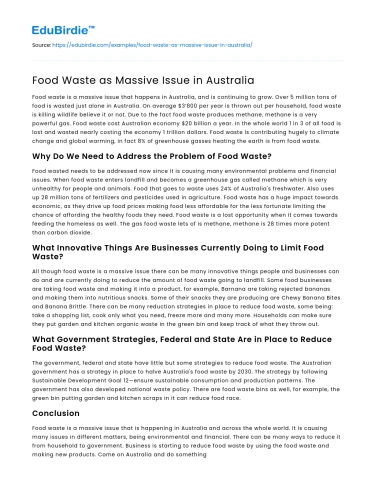Introduction
Food waste has emerged as a significant environmental, economic, and social issue in Australia, mirroring global trends of excessive resource wastage. The National Food Waste Baseline estimated that Australia generated approximately 7.3 million tonnes of food waste in 2016-17 alone, with households contributing the largest share. This waste not only represents a loss of valuable resources but also contributes significantly to greenhouse gas emissions, as decomposing organic matter releases methane, a potent greenhouse gas. Addressing food waste is crucial not only for environmental sustainability but also for economic efficiency and social equity. In this essay, we will explore the multifaceted nature of food waste in Australia, examining its causes, implications, and potential solutions. Through an analysis of current policies and innovative practices, we aim to underscore the urgent need for comprehensive strategies to mitigate food waste effectively.
Understanding the Causes of Food Waste
The root causes of food waste in Australia are complex and multifaceted, deeply embedded in the socio-economic fabric of modern society. At the household level, a lack of awareness about the environmental impact of waste and inadequate planning of food purchases contribute significantly to wastage. According to a study by the Commonwealth Scientific and Industrial Research Organisation (CSIRO), Australians discard up to 20% of the food they buy, often due to over-purchasing and mismanagement of perishable goods. Additionally, cultural attitudes toward food abundance and perfection standards set by retailers further exacerbate this issue. Retailers often reject produce that does not meet aesthetic standards, despite its nutritional adequacy. This leads to substantial pre-consumer waste, highlighting the need for a paradigm shift in consumer perceptions and retail practices.
Save your time!
We can take care of your essay
- Proper editing and formatting
- Free revision, title page, and bibliography
- Flexible prices and money-back guarantee
In the agricultural sector, inefficiencies in harvesting, storage, and transportation also contribute to significant food losses. Seasonal gluts, unpredictable weather patterns, and market fluctuations can lead to situations where produce is left unharvested. Moreover, logistical challenges such as inadequate cold storage facilities and transportation infrastructure further compound these losses. As Australia continues to grapple with the effects of climate change, these challenges are likely to intensify, necessitating adaptive strategies to optimize the food supply chain. Addressing these underlying causes requires concerted efforts involving education, policy reform, and technological innovation.
Implications of Food Waste and Counter-Arguments
The implications of food waste in Australia are far-reaching, affecting environmental, economic, and social dimensions. Environmentally, food waste contributes to approximately 8% of global greenhouse gas emissions, with landfills being the third-largest source of methane emissions in Australia. Economically, the cost of food waste is estimated at $20 billion annually, encompassing both direct and indirect costs. This financial burden extends to households, businesses, and the government, highlighting the inefficiency of current practices. Socially, the ethical implications of food waste are profound, particularly in a country where food insecurity affects 1 in 6 Australians. This dichotomy between waste and need underscores the moral imperative to address food wastage.
Critics may argue that food waste is an inevitable byproduct of modern consumer society, citing the convenience-driven culture and complex supply chains as insurmountable obstacles. However, this perspective overlooks the potential for systemic change through policy interventions and technological advancements. For instance, countries like France have implemented legislation mandating supermarkets to donate unsold food to charities, significantly reducing waste. Furthermore, technological solutions such as smart inventory management and innovative packaging can extend the shelf life of products, challenging the notion that food waste is an unavoidable consequence of contemporary living.
Strategies for Reducing Food Waste
To effectively tackle food waste in Australia, multifaceted strategies encompassing policy, education, and innovation are imperative. Policy measures such as the National Food Waste Strategy aim to halve food waste by 2030, aligning with global initiatives like the United Nations Sustainable Development Goals. These strategies emphasize collaboration across sectors, encouraging businesses, governments, and individuals to adopt sustainable practices. Educational campaigns play a crucial role in raising awareness and changing consumer behavior, promoting practices such as meal planning, portion control, and proper storage techniques.
Technological innovation also holds promise in mitigating food waste, with advancements in food processing, packaging, and preservation offering potential solutions. For example, the use of blockchain technology in supply chains can enhance transparency and traceability, reducing losses through better inventory management. Additionally, apps that connect consumers with surplus food from restaurants and retailers have gained traction, facilitating the redistribution of food that would otherwise go to waste. By embracing these strategies, Australia can not only reduce its food waste but also pave the way for a more sustainable and equitable food system.
Conclusion
Food waste in Australia is a multifaceted issue with significant environmental, economic, and social ramifications. Addressing this challenge requires a holistic approach that combines policy reform, educational initiatives, and technological innovation. By understanding the root causes and implications of food waste, stakeholders can develop effective strategies to mitigate its impact. The successful reduction of food waste will not only contribute to environmental sustainability but also promote economic efficiency and social equity. As Australia strives to meet its national and international commitments to reduce food waste, collective action and continued innovation will be paramount. Through concerted efforts, Australia can transform its food system, setting a precedent for global sustainability and resource conservation.






 Stuck on your essay?
Stuck on your essay?

